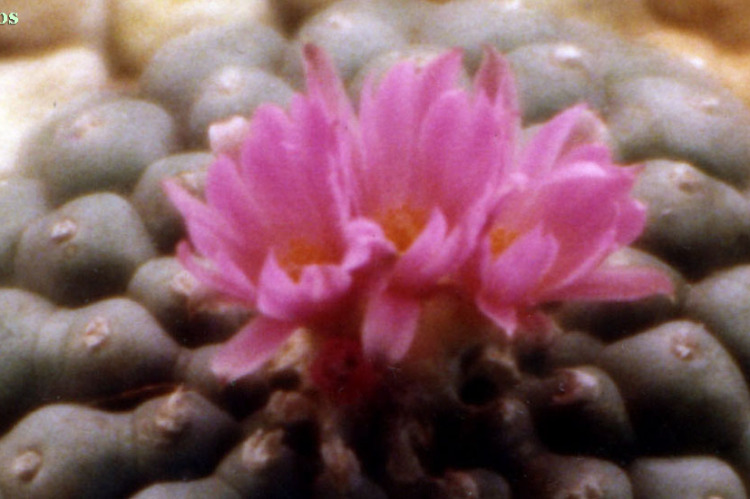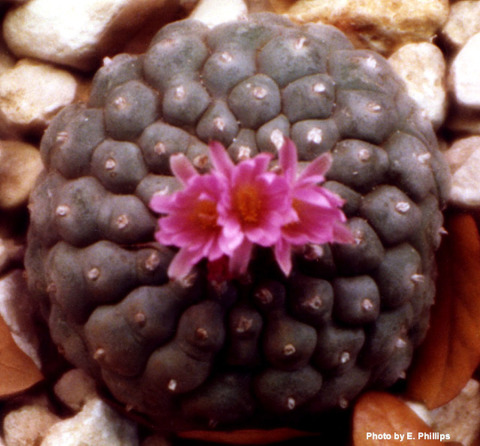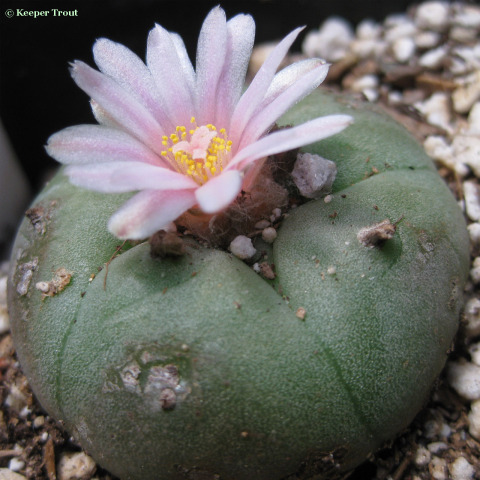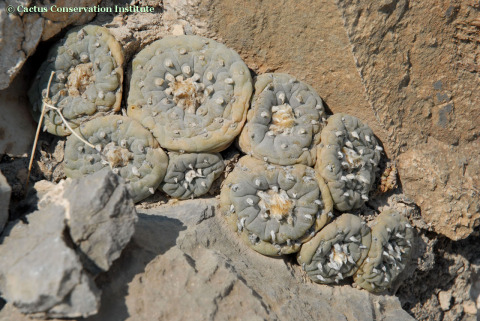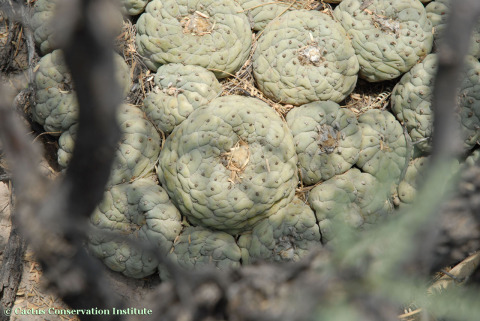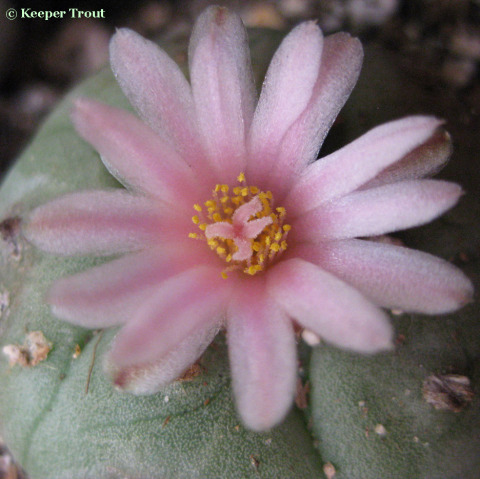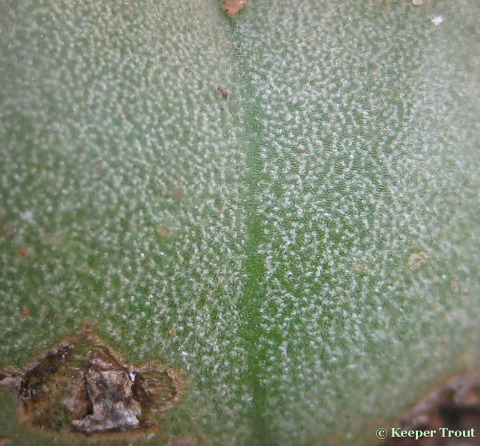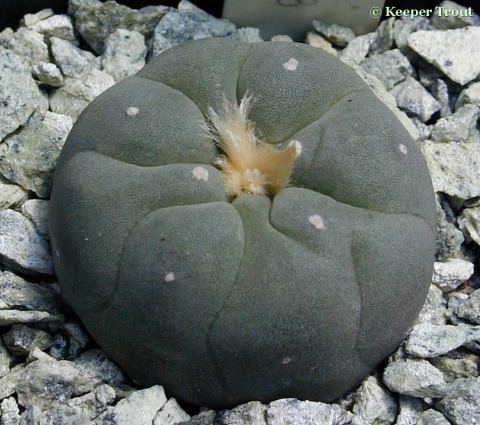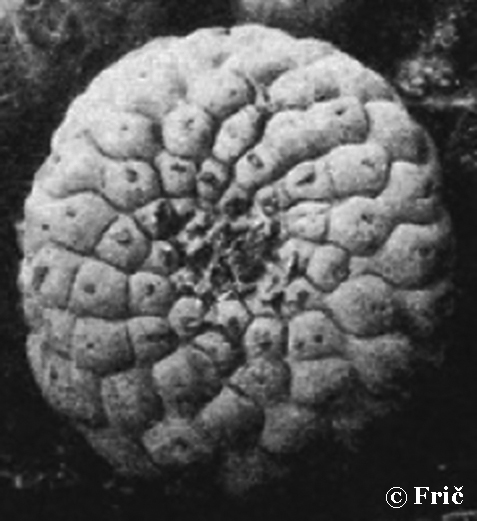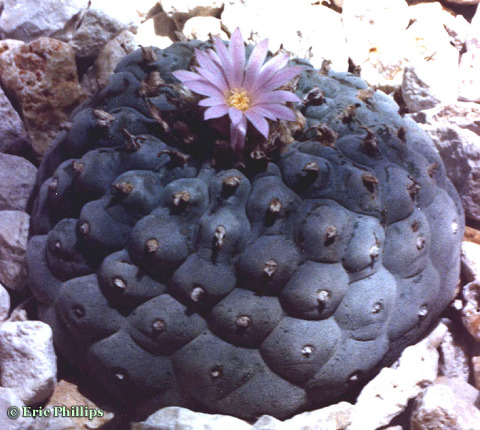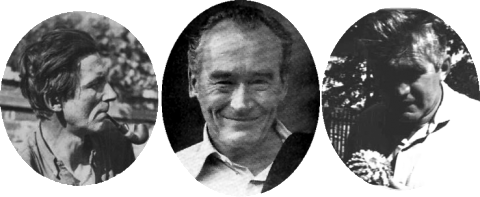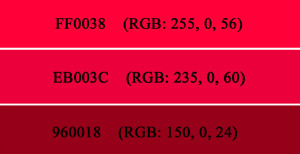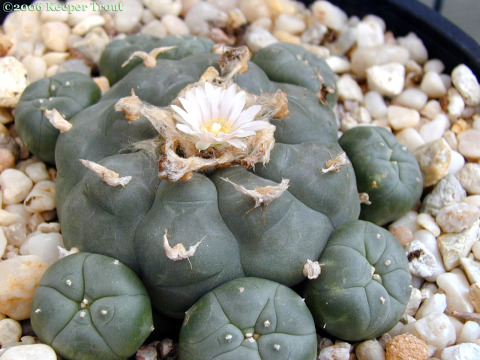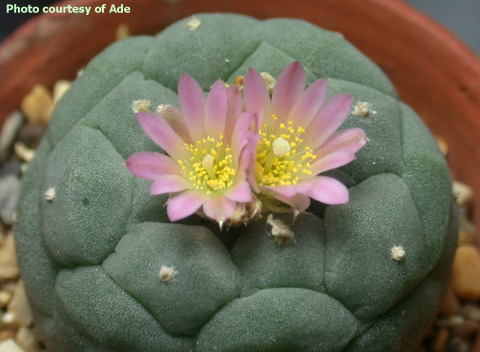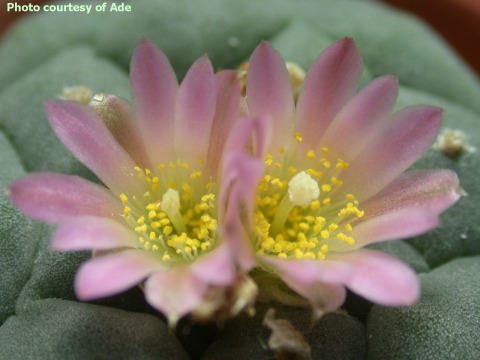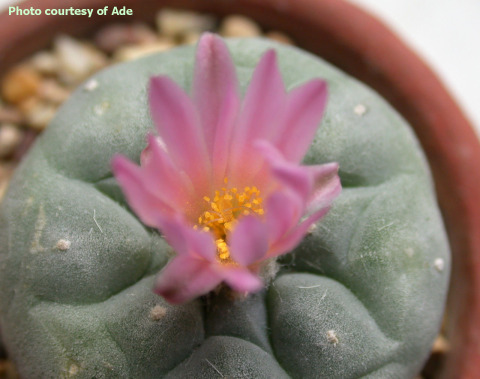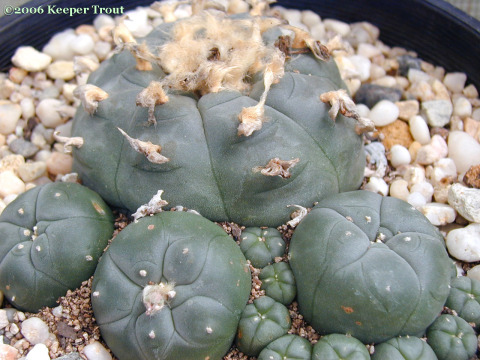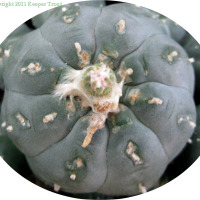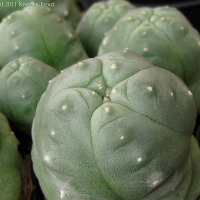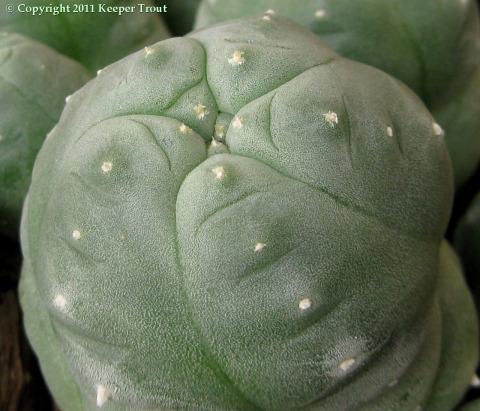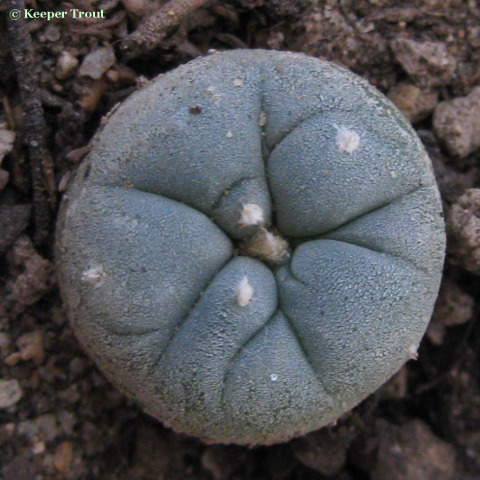Lophophora fricii Habermann
Vlastimil Habermann (1975) Kaktusy (Brno), 10: 123, as Lophophora fricii.
Most people who have studied peyote recognize this as an accepted species. The IPNI still lists it as an unresolved name. Someday that will change.
Reported to contain trace amounts of mescaline.
Japanese name: Ginkangyoku
Origin: Limestone hills and soils near San Pedro, Coahuila, Mexico.
Habitat: There are two wild forms of Lophophora fricii occurring some miles (~20) apart from each other.
One is a montane form that does not have as many offsets or form as large of planchas as the second one. It also tends to be flatter and look almost melted.
The second one grows in silt flats and forms large clumps.
There is a photo said to be from Fric in 1924 and published in 1925 which is an article that I have not yet obtained. Images of that photo appearing online look very much like a single crown from the image below.
Associated plants
A detailed list does not appear to exist yet for either population. The following can be observed in CCI photographs online:
Agave spp., Echinocereus stramineus, Jatropha dioica,, Larrea tridentata, Opuntia rufida & a Prosopis sp.
Lophophora fricii species nova Habermann
Corpus molle est coloris opace griseo-viridis usque subfulvi, plano globosum, cum apice modice depresso, ad 8 cm altum et ad 12 cm diametiens, solitarium, partim proliferans, cum radice rapiformi.
Costae humiles numero 8-14, iam ab apice evidentes, modice spiraliter tortae, 15-20 mm latae, evidenti fissura recta fere dividuntur. Podaria in costis fissuris saepe male evidentibus dividuntur. Areolae rotundae, 3 mm diametientes, 8-15 mm inter se distant, spinis vacant, sed fasciculos densos pilorum sericorum alborum ad 15 mm longos ferunt; in areolis veteribus partim circumrasae sunt. Pili formant in vertice tegumen densum, ex quo flores carmineorubri efficiuntur. Flores apicales, infundibuliformes, ad 25 mm longi et ad 25 mm diametientes. Pericarpellum nudum, subviride, tubus brevis, infundibuliforma dilatatur. Phylla perigonii exteriora lanceolata cum acumine firmo, externe fusco brunneo. Phylla perigonii interiora lanceolata plerumque in duabus seriebus, cum margine integro, 3-4 mm lata, 15 mm longa, coloris carmineorubri, cum paulo fusciore stria media. Stylus albus, 8-10 mm longus, cum stigmatibus 5 albis. Stamina multa, alba, cum antheris flavis, que stylo breviora sunt. Fructus carmineus, ad 20 mm longus, 4 mm latus, claviformis, nudus, cum residu.is siccatis perianthi in cauda. Semina galeriformia, 1,5 mm longa, 1,2 mm lata, cum hila basali alba in V-forman compresso. Funiculus in medio cavernae positus, micropyllum in rostratestae prope hilum evidens est. Testa glauca, nigra, tuberculis ovalibus tecta, que in vicinitate hili minuuntur. Embryon oviforme, modice applanatum, cum perispermio adiacenti.
Habermann 1974b
Differuntur a L. williamsii colore corporis griseo-viridi usque subfulvo, forma costarum, flore carmineorubro, seminibus cum testa asperiore et hilo in V -forma depresso.
Lophophora fricii Habermann
Habermann’s description gave stems as solitary or scarcely branching but its clear that nice clumps exist in the wild.
The crown is depressed-globose, with a sunken apex, reaching 12 (or more) cm. in diameter, and up to 8 cm. high.
Possesses large and fusiform (spindle-shaped) roots.
Epidermis is gray yellowish-green; 14 ribs (and more), areoles are nearly circular, 2-3 mm in diameter, 8-15 mm. apart, with tufts of dense, silky white hairs, without spines (a few miniature spines present in young seedlings only, soon breaking off); flowers from areoles near the apex of the stem, 25 mm long, 25 mm. in diameter, pelicarp naked, greenish; short tube, funnelform, pink, outer segments of pelianth oblanceolate, with greenish mid-stripe, inner segments oblanceolate, margin entire, 3-4 mm. broad, 15 mm. long, deep carmine red and velvet sheen; style white, stigma lobes 5, white; anthers yellow, filaments white, stamens shorter than style; fruit clavate, bare, with dried perianth remains, 20 mm. long, 4 mm. in diameter, red; seed black, papillate, 1.5 mm. long, 1.2 mm broad, hilum broad, V-shaped, micropylar aperture at rostrum close to the hilum; embryo ovoid. Mexico, Coahuila, limestone soils in the desert near San Pedro.
Holotype no. L-5.
Lophophora fricii is said to differ from Lophophora williamsii due to its larger size, a higher number of ribs, the color of the stem, and due to the color and sheen of the flowers.
Habermann commented that it was the only Lophophora that has seed with a V-shaped hilum. (L. alberto-vojtechii was later found to possess this feature as well.) “V-shaped” might need to be better, or at least more narrowly, defined as L. williamsii can also be said to have a v-shaped hilum. (See the hilum of the seeds in this L. williamsii image.)
Frič had found this plant and published a photograph in 1924 as Anhalonium sp. fl. rosea Frič. In Kreuzinger 1935 the image had become a rose-colored flower form of L. williamsii.
Drawn primarily from Habermann with additional comments based on imagery from the CactusConservation.com website.
Useful search terms for locating additional imagery online:
银冠玉(Lophophora fricii)
白花銀冠玉(Lophophora fricii f. albiflora)
银冠玉缀化(Lophophora fricii f. cristata)
Lophophora fricii Habermann
[Published in Habermann 1974b & 1975a]
Grey-green skin. Carmine red flowers. (None of the flowers encountered, in either pictures or specimens of plants presented as this species, have been carmine)
Collected in vicinity of San Pedro in Coahuila, Mexico by Denis “Dennis” Cowper.
Habermann 1974b [Thought by Habermann to be the red flowered species that Fric described but this was assumed based on locality, flower color and Fric’s photograph.]
Alberto V. Frič discovered Lophophora fricii during his 1923-1924 travels in the U.S. and Mexico. Frič had referred to it as “Anhalonium sp. flora rosea.” in a photograph published in 1924. In 1935, he changed the name in the photograph to L. williamsii which may underlie the very commonly held notion that L. fricii is a synonym of L. williamsii.
Habermann said that a few of Frič’s original collection survived the transport to Czechoslovakia but was not clear about what became of them or how he knew about them.
Roman Štarha analyzed a specimen of both Lophophora fricii and sp. Viesca with very similar results.
Fric had commented that the plants were quite large, reaching 40 cm in diameter, and possessing 13-21 ribs. He gave their place of occurrence as the southern slopes of limestone hills of the Sierra Bola, near San Pedro in Coahuila, Mexico.
Using that information, Cowper was able to rediscover a few plants at the same locality mentioned by Frič. It was those specimens that were used by Habermann for his description of L. fricii.
Habermann described this plant as producing “carmine red” flowers. This might be a matter of color definitions but none of the flowers encountered, in either pictures or as living specimens, have been carmine)
(See some color samples below.)
It is also clear that pink, dark pink and white flowers can occur in some L. fricii.
Lophophora fricii var. decipiens is a variety that is recognized in horticulture.
Care must be taken not to equate this with Crozat’s Lophophora decipiens as the “decipiens” morphology is a body form which can also readily be found in wild populations of Lophophora diffusa and also in some populations of Lophophora williamsii, and also in some presently ill-defined Mexican Lophophora populations that are shown in Bohata et al. 2005. The use of “decipiens” as a horticultural varietal name, or as a description of this body morphology, is certainly sound enough but the attempts to assign Croizat’s L. decipiens as a synonym is, at best, on some shaky ground.
A noteworthy point was made by Gerhard Koehres that unlike the other Lophophora species, Lophophora fricii has fragrant flowers.
Koehres determined L. fricii to be self sterile.
Koehres was unable to pollinate L. fricii using pollen from L. diffusa and from L. koehresii. Using the pollen of L. fricii Koehres was however able to produce seeds in both L. koehresii and L. williamsii El Huisache.
Kada reported a failure to fertilize L. fricii after 7 attempts involving L. diffusa pollen, 13 with L. williamsii and 18 L. koehresii pollen but reported 1 apparent success for an attempt involving a self-fertile L. williamsii. Kada also reported a lack of success using L. fricii pollen to on L. diffusa, L. koehresii and L. williamsii.
Reported chemistry of Lophophora fricii:
- Lophophora “tesselatus”
- Lophophora “tesselatus”
- Lophophora “tesselatus”
Reported analysis of Lophophora sp. var. Viesca
from Viesca, Mexico
Also spelled. sp. Vieska in European cultivation. (This has been determined to be Lophophora fricii)

